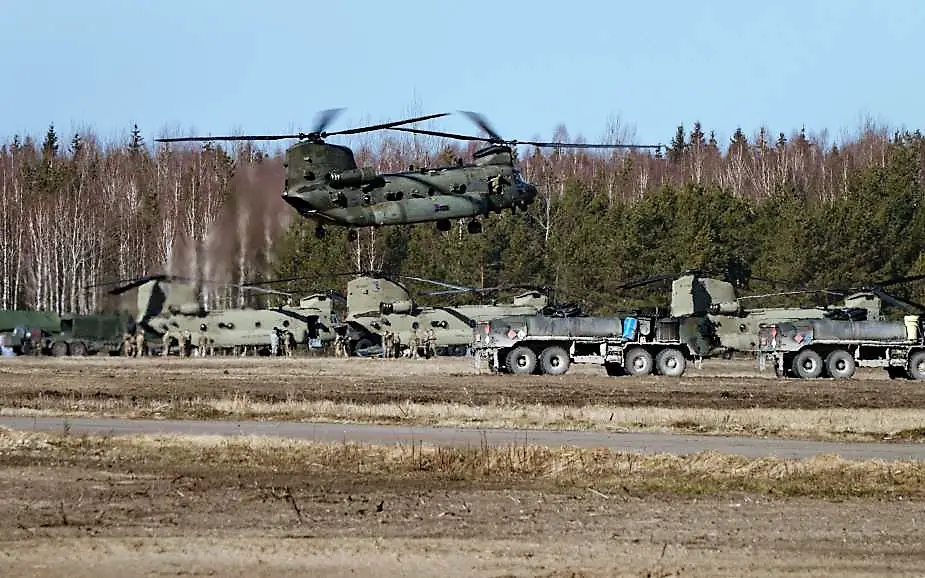Breaking news
Chairman of US Joint Chiefs of Staff Milley proposes rotational forces in permanent bases across Eastern Europe.
The future of American presence on the eastern flank of NATO may revolve around rotational forces on permanent bases, the chairman of the Joint Chiefs of Staff told the House Armed Services Committee on April 5, Jim Garmone reports. "Actual presence is always a good deterrent relative to a given threat," said Army Gen. Mark A. Milley. Milley and Secretary of Defense Lloyd J. Austin III testified before the committee on the fiscal 2023 Defense budget request.
Follow Army Recognition on Google News at this link

A British CH-47 Chinook heavy-lift transport helicopter prepares to refuel after disembarking paratroopers during an air assault exercise conducted by the United States, Lithuania and the United Kingdom at Kazlu Ruda, Lithuania, March 1, 2022. (Picture source: U.S. DoD/Army Staff Sgt. Thomas Mort)
The United States already employs rotational units in the Baltic Republics and Poland. Since the Russian invasion of Ukraine, more have deployed to the Baltics, Poland, Romania, Hungary and Slovakia. At the latest NATO Summit in March, leaders agreed to study the alliance's troop posture in Europe.
Representatives asked Milley about the possibility of American troops based permanently in the front-line states with Russia. "My advice would be to create permanent bases but don't permanently station," he said. This gives the effect of permanence by cycling rotational forces through these permanent bases. By doing that, the military does not incur the costs of family moves, post exchanges, schools, housing and so forth, Milley said. "So, you cycle expeditionary forces through forward-deployed permanent bases", the chairman said. "And I believe that a lot of our European allies, ... are very, very willing to establish permanent bases."
NATO is going through a process right now to examine the security architecture in Europe and how it should change given Russia's invasion of Ukraine. Austin said U.S. leaders expect to work with leaders from NATO allies on the troop posture picture. "If NATO deems that it's appropriate to change its footprint, then certainly we will be a part of that," the secretary said. "Our goal is to make sure that we continue to reassure our allies and partners, especially those that are on the eastern flank, and especially our allies that are in the Baltic area or Baltic region" . Austin believes the decision will be announced at the Madrid Summit this June.
The two men were also asked about lessons learned from the Russian invasion of Ukraine. Austin said he speaks with his Ukrainian counterpart Defense Minister Oleksii Reznikov often. "We do want to make sure that we are meeting their needs, and we're providing them the things that are most useful ... to their fight," he said. "The things that we have provided them have been very, very instrumental in their efforts to blunt the advance of an overwhelming Russian force."
The anti-armor and anti-aircraft capabilities have been effective as has the use of unmanned aerial vehicles, Austin said. One unheralded capability is the use of secure, tactical radios that has allowed the Ukrainians to maintain command and control through the battles with Russian forces. "So, we will continue to focus on those types of things that have been most useful to them, as well as emerging needs that the Minister of Defense identifies," he said.
Austin also said that simply having a capability doesn't mean it will be successful. "The Russians have a significant mechanized capability," he said. "But as you look at the techniques and tactics, procedures that they used, they were not very effective. "So, you question the training, the leadership at the at the noncommissioned officer level and their ability to provide basic logistics to a force that size," he continued. "Those are the things that have given them significant problems over the over the last several weeks."
Austin also pointed to the failure of the Russians to link air and ground units effectively. "I think, because the Russians have not been effective in using their armor, it does not mean that armor is ineffective on the battlefield going forward," he said. "It means that they were ineffective because of the things that they failed to do in this fight."
Milley pointed to the importance of intelligence and intelligence sharing.
Strong leadership from the national to the tactical level is of critical importance, and Milley praised Ukrainian President Volodymyr Zelenskyy for his leadership in the crisis. He also highlighted the captains, lieutenants and NCOs at the tactical level. "Ukraine has been trained by the United States since 2014," he said. "And they have given me feedback personally saying that that training has been quite effective in terms of the concepts of mission command, distributed junior level leadership, development of an NCO Corps."
The Ukrainian military has junior personnel who are encouraged to use initiative. This is not present in the Russian army, Milley said.

From left: Army Gen. Mark A. Milley, chairman of the Joint Chiefs of Staff; Secretary of Defense Lloyd J. Austin III and Mike McCord; undersecretary of defense (comptroller)/chief financial officer, appear before the House Armed Services Committee for a hearing in Washington on the fiscal 2023 defense budget request, April 5, 2022. (Picture source: U.S. DoD/Air Force Tech. Sgt. Jack Sanders)

























